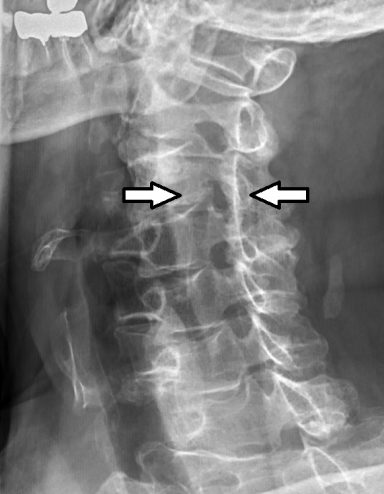If you suffer from a C5-C6 foraminal stenosis severe, you probably worry about theevolution of your condition, and you wonder which treatment would suit you best. There are several different options, and it can be difficult to decide which is best.
In this article, we will address this condition with a focus on the different treatments available. This will help you decide which is best for you, together with your healthcare professional.
La foraminal stenosis severe C5-C6, what is it exactly?
There’s plenty of spinal nerves exit the spinal canal between the vertebrae through a tunnel called the intervertebral foramen. Foramen stenosis occurs when this tunnel narrows, particularly due to the collapse of a disc.
This phenomenon can put pressure on the spinal cord or nerve roots and cause pain, numbness or weakness in the affected area.
In severe cases, it can even lead to paralysis. The foraminal stenosis is more common in people over 50 and is more likely to occur if you have a history of back problems.
As the name suggests, the C5-C6 foraminal stenosis occurs at the level of cervical spine, between the C5 and C6 vertebrae. It is quite common, mainly because the neck is one of the most mobile segments of the body. This element, in addition to the role of support for the head, makes the cervical vertebrae potentially the site of pathology leading to the narrowing of the intervertebral foramina.
Causes and symptoms of foraminal stenosis strict
The most common cause of foramen narrowing is wear and tear from aging. The bones of the spine may begin to rub against each other or bulge and compress the foramen.
There’s plenty of cervical hernias, bone spurs and swelling of inflamed joints can also lead to foramen stenosis. Women are also more likely to develop foraminal stenosis only men. People who have already had spinal surgery are also more at risk.
The symptoms of foraminal stenosis include spinal pain that sometimes radiates to the upper (arms, shoulders) or lower (thigh, leg) extremities. Patients may also experience numbness, tingling, or weakness in the affected arm or leg.
C5-C6 foraminal stenosis severe, what particularities?
It is important to note that the severity of the foraminal stenosis is not necessarily proportional to the severity of the condition or the intensity of pain experienced by a person. In other words, a person can suffer from a foraminal stenosis very severe but relatively painless, whereas another person may have only a mild case but experience great pain.
This is because the foramen is not the only source of nerve blockage in spinal stenosis; other structures such as the spinal cord or nerve roots may also be affected.
Therefore, the severity of foramen stenosis must be considered in conjunction with other factors to determine the overall severity of the condition.
Some people remain asymptomatic despite C5-C6 foraminal stenosis severe visible on medical imaging. The reason for this situation is not yet clear, but it may be due to factors such as the location of the stenosis, age, the presence of inflammation, or even the person's state of health.
There are two main types of foraminal stenosis : light and serious. A foraminal stenosis mild may cause no symptoms, or only mild pain and stiffness.
On the other hand, a C5-C6 foraminal stenosis severe can just as well be extremely painful and lead to neurological problems. This is because the spinal nerves that pass through the foramen can become irritated, causing pain, inflammation, numbness, or weakness.
What treatment for a C5-C6 foraminal stenosis strict ?
Even if a foraminal stenosis severe can be extremely painful, the first stage of treatment is usually conservative treatment. This includes:
- Medication : analgesics, anti-inflammatories, muscle relaxants.
- Kinesitherapy (physiotherapy): exercises to strengthen muscles and improve flexibility.
- Rest : temporary rest can allow the body to heal, and provide an optimal environment for good rehabilitation.
- Apply ice or heat to the affected area : to help relieve pain.
- Correcting posture: to reduce stress on the spine.
- Grandma's Remedies: a warm bath with baking soda, Epsom salt or ginger, a massage with essential oils such as lavender, chamomile, rosemary or juniper. However, these modalities are not scientifically proven, and must be used in conjunction with a medical approach.
- Acupuncture: to relieve pain by stimulating pressure points.
- Chiropractic care: to relieve pressure on the nerves.
- Electrical stimulation: to reduce pain and inflammation.
- Yoga: to improve flexibility and reduce stress.
What if conservative treatments don't work?
In the event that conservative treatment does not relieve pain, more invasive therapies may be chosen. If there are signs of nerve damage between the cervical vertebrae, or the foraminal stenosis severe prevents optimal healing.
It is recommended to proceed with a series of infiltrations, followed by surgery as a last resort. The goal of these more aggressive treatments is to reduce pain, and improve overall function.
In some cases, they can also help prevent further damage to the spine. While these therapies may be effective, they may also be associated with significant risks.
The goal of surgery is to relieve pressure on the nerves by widening the foramen. This can be done by a laminectomy (removal of a small part of the bone) or a foraminotomy (widening of the foramen). Surgery is usually successful in relieving pain, but it is important to note that it may not completely cure the condition.


